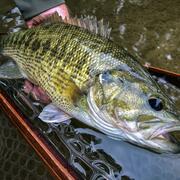Coral reef fish assemblage in the Kealakekua Bay Marine Life Conservation District off the leeward side of Hawaiʻi Island, Hawaiʻi on 11 November 2016.
Tim Grabowski, PhD
Unit Leader - Hawaii Cooperative Fish and Wildlife Research Unit
Research Interests
Tim is interested in the behavioral and physiological ecology of fishes and applying these fields to management and conservation issues. His research tends to focus on the reproductive ecology of fishes as well as local adaptation and population structuring.
Teaching Interests
Tim currently teach field ichthyology and foundations of ecology and conservation biology at Texas Tech University. He also teaches a summer course at the University of Iceland examining the effects of anthropogenic impacts, such as climate change and commercial fisheries, on the marine environment.
Professional Experience
Unit Leader, Hawaii Cooperative Fishery Research Unit, 2016-
Assistant Unit Leader, Texas Cooperative Fish and Wildlife Research Unit, 2010-2016
Education and Certifications
Ph D Clemson University 2006
MS Texas A&M University 2002
BS Texas A&M University 1999
Science and Products
Studying the Influence of Streamflow Variability on Fish Populations to Understand Nutrient Transport in Hawaiian and Alaskan Streams in a Changing Climate
Impacts of Extreme Events on the Native and Nonnative Aquatic Species of Hawaiʻi Stream Ecosystem
Guadalupe Bass flow-ecology relationships; with emphasis on the impact of flow on recruitment
Coral reef fish assemblage in the Kealakekua Bay Marine Life Conservation District off the leeward side of Hawaiʻi Island, Hawaiʻi on 11 November 2016.
Age, growth, and reproductive biology of Achilles tang (Acanthurus achilles) around Hawai'i Island, USA Age, growth, and reproductive biology of Achilles tang (Acanthurus achilles) around Hawai'i Island, USA
Assessing habitat use and population dynamics of fisheries resources at Kaloko Fishpond Assessing habitat use and population dynamics of fisheries resources at Kaloko Fishpond
Analysis and review of fishery-dependent data for Hawaiian nearshore noncommercial fisheries Analysis and review of fishery-dependent data for Hawaiian nearshore noncommercial fisheries
Pandemic-driven changes in the nearshore non-commercial fishery in Hawai'i: Catch photos posted to social media capture changes in fisher behavior Pandemic-driven changes in the nearshore non-commercial fishery in Hawai'i: Catch photos posted to social media capture changes in fisher behavior
Mismatch between temperature and discharge disrupts spawning cues in a fluvial specialist, blue sucker Cycleptus elongatus Mismatch between temperature and discharge disrupts spawning cues in a fluvial specialist, blue sucker Cycleptus elongatus
Mismatch between temperature and discharge disrupts spawning cues in a fluvial specialist, blue sucker Cycleptus elongatus Mismatch between temperature and discharge disrupts spawning cues in a fluvial specialist, blue sucker Cycleptus elongatus
Endemic Guadalupe bass (Micropterus treculii) are supported by isotopically distinct resources in tributary versus mainstem river food webs Endemic Guadalupe bass (Micropterus treculii) are supported by isotopically distinct resources in tributary versus mainstem river food webs
Blue sucker habitat use in a regulated Texas river: Implications for conservation and restoration Blue sucker habitat use in a regulated Texas river: Implications for conservation and restoration
Estimating detection and occupancy coefficients for the Pacific Islands coral reef fish species Estimating detection and occupancy coefficients for the Pacific Islands coral reef fish species
Ontogenetic shifts in mesohabitat use of young-of-year Rio Grande blue sucker in the Big Bend region of the Rio Grande Ontogenetic shifts in mesohabitat use of young-of-year Rio Grande blue sucker in the Big Bend region of the Rio Grande
Recruitment dynamics and reproductive ecology of Blue Sucker in Texas, with a focus on the Big Bend region of the Rio Grande Recruitment dynamics and reproductive ecology of Blue Sucker in Texas, with a focus on the Big Bend region of the Rio Grande
Looking for love under the ice: Using passive acoustics to detect burbot (Lota lota: Gadidae) spawning activity Looking for love under the ice: Using passive acoustics to detect burbot (Lota lota: Gadidae) spawning activity
Science and Products
Studying the Influence of Streamflow Variability on Fish Populations to Understand Nutrient Transport in Hawaiian and Alaskan Streams in a Changing Climate
Impacts of Extreme Events on the Native and Nonnative Aquatic Species of Hawaiʻi Stream Ecosystem
Guadalupe Bass flow-ecology relationships; with emphasis on the impact of flow on recruitment
Coral reef fish assemblage in the Kealakekua Bay Marine Life Conservation District off the leeward side of Hawaiʻi Island, Hawaiʻi on 11 November 2016.
Coral reef fish assemblage in the Kealakekua Bay Marine Life Conservation District off the leeward side of Hawaiʻi Island, Hawaiʻi on 11 November 2016.





